The landscape in which the baptism of Christ is usually portrayed is a rocky wilderness, with craggy mountain peaks in the background and cliff-like stony river banks on either side of the Jordan. While Jesus stands in the middle of the river itself, John is always portrayed in the classic icons as standing up on one of the river banks, never in the water.
The challenge of representing this uneven terrain and situating human figures in it proved difficult for the early artists. For the viewer, the corresponding challenge is that of comprehending the placement of the human figures in relation to the indicated forms of the landscape. This is certainly the most fascinating visual element of the composition of the baptism scene. The catacomb painting we have already examined solved the problem by depicting the moment after the baptism had been completed, when John is helping Jesus climb out of the river. The sarcophagus from Santa Maria Antigua put the feet of John and Jesus at nearly the same level, thus eliminating the problem. This of course demands that the Jordan be extremely shallow, and later artists were insistent on showing the water to be at least waist-high on the baptized Jesus. A commonly used solution is the one employed in the Arian Baptistery in Ravenna: the two banks are represented, and the water is simply heaped up between them by a sort of artistic fiat —even though it rises higher than the banks. Schiller reproduces a number of eccentric renderings of “water in a heap” (pp. 392-394 of her work), one of the most striking of which is Verdun’s Klosterneuberg altar, in which the decorative undulating lines of the water rise in a perfect arc to cover Christ to the waist. This approach certainly has the advantage of obviating any need for the river banks, thus eliminating the problems of design and composition related to them.
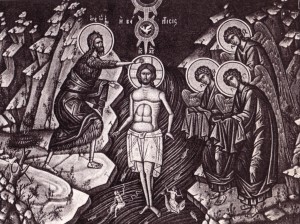
In the classic icon presentation, however, the river banks are present as two cliffs rising steeply on either side of Christ, providing a strong vertical division in the center of the image. Are these verticals intended actually to represent cliffs, or do they hint at the banks of a river rendered in perspective, rising up the surface of the page to indicate movement toward a vanishing point? This is a difficult question, and must be decided case by case. In some pictures, it seems clear that no hint of perspective, no vanishing point whatsoever, is intended: these lines indicate steep cliffs. But in many other representations, the two lines widen considerably toward the bottom of the picture plane, drawing closer together toward the top (for instance the baptism in the Capella Palatino in Palermo. In a fresco by Photios Kontoglou, the impression of the river coming forward from a distant background is inescapable, although the clues to perspective are hardly the conventional and systematized ones a western viewer would look for. The ambivalence of Giotto’s interpretation of the landscape is highly instructive: He gives us rocky cliffs without a doubt, but they serve the added purpose of hiding the more distant background from our sight. We are left with a fine stage setting; almost an interior with a bold blue back-cloth.
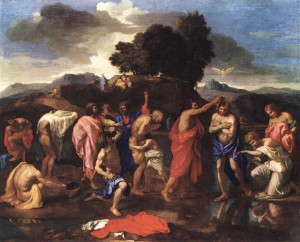
In the traditions represented in the Book of Hours, artists tended to portray local contemporary landscapes, thus easing the demands of reconciling steep cliffs with vanishing points. In the Tres Riches Heures of the Duke of Berry, painter Jean Colombe presents the baptism as taking place in a quaint little European landscape, in a shallow stream in the middle of a meadow.
From these steep cliffs, we can turn directly to Piero Della Francesca’s Baptism of Christ to see the river banks interpreted as almost ludicrously flat, and in perfect deep perspective. This Christ in Arcadia stands on dry ground just in front of a sort of long reflecting pool. It is interesting to note that Francesca has added a tree immediately at Christ’s side, perhaps to compensate for the otherwise complete loss of strong vertical elements in the landscape. Poussin situates his biblical figures in a southern European landscape; while a painting from Bali also emphasize characteristics of its own local landscape.
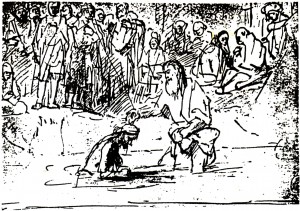
Rembrandt, exercising complete sovereignty over compositional decisions, adopts a point of view on the far shore, looking back at John and Jesus with only one river bank behind them. This raises the question of where the viewer would be if inserted into the represented space of the traditional icon, and suggests the answer: hovering in mid-air above the middle of the river, downstream from Jesus. Of course the question and the answer are equally nonsensical when dealing with the Orthodox icon, which signals its two-dimensionality so clearly, and eschews fooling the eye or creating a window. This Dutch master thereby trades the sharp verticals for a pair of long horizontals. Notice that both Rembrandt and the artist from Bali (Ketut Lasia) put John in the water with Christ (a rare move).
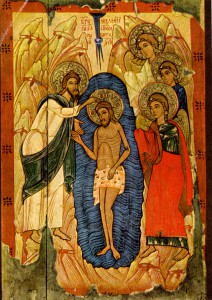 Leonid Ouspensky further complicates this question of how to interpret the rendering of the river banks by offering an evocative reading of the classic icon’s composition: “The Saviour is represented standing, as it were, against a background of water, as though in a cave. This gives us to understand that not a part of His body, but His whole body is immersed in token of His burial…” (Ouspensky and Lossky, Meaning, p. 164). Ouspensky thus invests the wedge of dark negative space around the body of Christ with symbolic and pictorial significance. His interpretation may or may not be related to Schiller’s speculations about visual references to “the cave of the Baptism” in the icons of this event (Schiller, p. 135). She cites Hosios Loukas as especially suggestive of a cavern structure. At any rate, it is a compelling suggestion he offers, even though it simply does not apply to a great number of the depictions. In many icons, the form of Christ is not surrounded completely by the field of paint defining the Jordan’s waters. However, Ouspensky’s reading of the negative space (a design element he manipulates masterfully in his own work) does help make sense of a number of icons in which the shape of the water is stated in very strong abstract relief. A seventeenth-century Ukranian icon, for example, sets Christ within a bright blue cocoon, which stands out sharply from the pale tan color shared by the earth and sky, as well as the garments of John and one of the angels (Christ’s usual baptismal nudity is here covered up by a striking wrap). The encompassing blue can indeed be instructively read as a visual analog to total immersion, full experience of death, and entombment.
Leonid Ouspensky further complicates this question of how to interpret the rendering of the river banks by offering an evocative reading of the classic icon’s composition: “The Saviour is represented standing, as it were, against a background of water, as though in a cave. This gives us to understand that not a part of His body, but His whole body is immersed in token of His burial…” (Ouspensky and Lossky, Meaning, p. 164). Ouspensky thus invests the wedge of dark negative space around the body of Christ with symbolic and pictorial significance. His interpretation may or may not be related to Schiller’s speculations about visual references to “the cave of the Baptism” in the icons of this event (Schiller, p. 135). She cites Hosios Loukas as especially suggestive of a cavern structure. At any rate, it is a compelling suggestion he offers, even though it simply does not apply to a great number of the depictions. In many icons, the form of Christ is not surrounded completely by the field of paint defining the Jordan’s waters. However, Ouspensky’s reading of the negative space (a design element he manipulates masterfully in his own work) does help make sense of a number of icons in which the shape of the water is stated in very strong abstract relief. A seventeenth-century Ukranian icon, for example, sets Christ within a bright blue cocoon, which stands out sharply from the pale tan color shared by the earth and sky, as well as the garments of John and one of the angels (Christ’s usual baptismal nudity is here covered up by a striking wrap). The encompassing blue can indeed be instructively read as a visual analog to total immersion, full experience of death, and entombment.
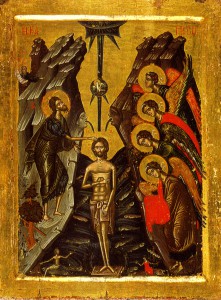
Just as (if Ouspensky is right) the tall dark wedge of the water may suggest Christ’s total immersion in death, the two sides of the Jordan may suggest the earthly and heavenly realms. More often than not, John and any human witnesses will occupy one side, while the angels occupy the other shore. This is sometimes no more than a matter of compositional balance: the artists at the Arian Baptistery in Ravenna, for instance, hit upon the same visual device even though it meant making a very large personification of Jordan serve as ballast on the left side of the tondo.
Also, the more crowded with onlookers an artist makes the scene, the less likely he is to observe this separation. Nevertheless, the heaven-earth interpretation of the two banks of Jordan seems to be a natural one that could well have been in the minds of the artists and viewers of images of Christ’s baptism. It is solidly grounded in the Old Testament typologies related to crossing water: from Egypt to the wilderness, from the desert to the promised land. One artist at least seems to have had this comparison in mind almost indisputably: the composer of the Schreiber edition of the Biblia Pauperum blockbook (Biblia Pauperum: A Facsimile and Edition by Avril Henry, New York: Cornell University Press, 1987). In this case the typological parallels just mentioned are presented clearly alongside Christ’s baptism as their antitype, signifying that the baptism is being interpreted as an event of crossing over. The composer of this woodcut edition of the Biblia Pauperum is unrelenting in his use of vertical or horizontal divisions to separate the residents of this world from the representatives of the world to come. Henry’s interpretations on pp. 34-35 are especially significant. One of the examples cited by Henry is the placement of Mary and Gabriel on opposite sides of a strong vertical division in the scene of the annunciation. This corresponds to the division of the two sides of this scene by an arched doorway in the classic Byzantine church program. It seems likely to me that in rendering the baptism in this way, with the heavenly and earthly on opposite shores and Christ mediating between them, the composer of the Biblia Pauperum has made visible a structure of meaning latent in the iconic configuration of the baptism scene down through history. This might explain why the angels and humans are grouped with their own kind even when compositional balance is not perfectly maintained thereby. Finally, there is occasionally a noticeable difference in the color of the cliffs on the two sides of the Jordan.
Having treated the physical characteristics of the Jordan as landscape, we can now investigate a much more unusual and startling way in which the river is present in icons: in personified form. There are many examples of this figure occurring in the icon of the baptism, and by and large they share certain identifying characteristics: Jordan is personified as a white-bearded old gentlemanly river-god draped in loose garments. Jordan may also, as at Nea Moni among many other places, be personified as a beardless youth. For an extensive discussion of this variation, see Doula Mouriki, The Mosaics of Nea Moni on Chios (Athens: Commercial Bank of Greece, 1985, volume 1, pp 123-124). This is an admittedly strange incursion of what seems like a paganizing motif into Christian iconography. Nevertheless, the Jordan figure should not be interpreted as a pagan deity (even if his iconography derives from that source), but as a simple personification; a poetic device rendered visual.
Although Mr. Jordan is an easily recognizable figure, there are significant differences among the many depictions of “old man river,” and these variants can be divided roughly into two major types: Jordan as friend and Jordan as foe. My argument in this matter relies on Robin Jensen’s article, “What are Pagan River Gods Doing in Scenes of Jesus’ Baptism?” (Bible Review 9:1, February 1993, 34-41). The difference between the two types can already be glimpsed as early as the two Ravenna baptisteries. The baptistery of the Arians features a Jordan who strikes the conventional, casual seated posture we would expect from a late classical river deity, draped in a green garment that leaves his muscular upper body bare. This Jordan looks like a close relative of Poseidon. His throne seems to be the overturned jug from which his eponymous river flows; his crown is a pair of crab claws; his scepter is a reed. He has a sort of ministerial role, as the royal host who provides the water necessary for the occasion. Perhaps he is also thought of as a witness to this great event, testifying that it happened here and not elsewhere. Jensen gives some noteworthy remarks about “sacred geography,” (Jensen, p. 36-37). His left hand is raised in what must be a gesture of reverence or at least salutation. This is Jordan as friend.
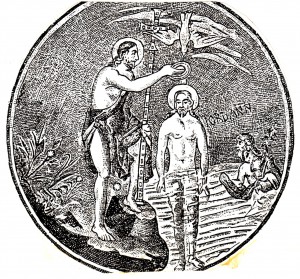 In Ravenna’s other 5th-century baptistery, the baptistery of the Orthodox, we see the first inklings of Jordan as foe. He is still the white-bearded, muscular figure, holding the rod of reed, but now he is in the background, smaller, partially submerged under water, and seen in profile. He seems to have a troubled expression on his face. In subsequent depictions, Jordan shrinks to fairy size, moves to the foreground, and casts a backward glance at Christ while fleeing in the other direction. He is less and less divine, and more nearly demonic (Jensen, p. 39). This portrayal, which has loosely been labelled “the eastern version” of the scene, casts Jordan as a representative of death and chaos, and shows him in the act of recognizing, perhaps ruefully, the Savior’s triumph. Ouspensky goes on to point out that a female figure may also appear, perhaps riding a fish. She is to be interpreted as a personification of the Red Sea, thus providing the two referents necessary to make sense of the Old Testament texts which are a part of the service celebrating this event: “The sea saw and fled: Jordan was turned back (Ps. 114:3)” (Ouspensky and Lossky, Meaning, p. 165). Thus with the inclusion of these two figures, a whole series of Old Testament types are invoked, too dense to unravel here: the Creator in opposition to primal chaos; the battle with the sea-monster Rahab; the Exodus from Egypt; the entry into Canaan; and Elisha’s crossing of the Jordan after Elijah’s ascent. Most of all, these tiny figures, and especially Jordan-as-foe, turn the icon of the baptism into a portrayal of Christ the savior striding into battle, and his enemies being scattered before him.
In Ravenna’s other 5th-century baptistery, the baptistery of the Orthodox, we see the first inklings of Jordan as foe. He is still the white-bearded, muscular figure, holding the rod of reed, but now he is in the background, smaller, partially submerged under water, and seen in profile. He seems to have a troubled expression on his face. In subsequent depictions, Jordan shrinks to fairy size, moves to the foreground, and casts a backward glance at Christ while fleeing in the other direction. He is less and less divine, and more nearly demonic (Jensen, p. 39). This portrayal, which has loosely been labelled “the eastern version” of the scene, casts Jordan as a representative of death and chaos, and shows him in the act of recognizing, perhaps ruefully, the Savior’s triumph. Ouspensky goes on to point out that a female figure may also appear, perhaps riding a fish. She is to be interpreted as a personification of the Red Sea, thus providing the two referents necessary to make sense of the Old Testament texts which are a part of the service celebrating this event: “The sea saw and fled: Jordan was turned back (Ps. 114:3)” (Ouspensky and Lossky, Meaning, p. 165). Thus with the inclusion of these two figures, a whole series of Old Testament types are invoked, too dense to unravel here: the Creator in opposition to primal chaos; the battle with the sea-monster Rahab; the Exodus from Egypt; the entry into Canaan; and Elisha’s crossing of the Jordan after Elijah’s ascent. Most of all, these tiny figures, and especially Jordan-as-foe, turn the icon of the baptism into a portrayal of Christ the savior striding into battle, and his enemies being scattered before him.
The preceding description of the two types of Jordan personifications has admittedly involved some rough handling of the evidence, but it is a distinction observed by reputable scholars, and one that has some merit. The two types appear contemporaneously with each other, and neither is demonstrably more primitive than the other. The division between “western” and “eastern” is only a rule of thumb. Above all, it should be noted that the signals are mixed throughout many of the examples cited: Ravenna’s Orthodox baptistery pictures Jordan holding a cloth, which is either Christ’s own garment or Jordan’s way of shrouding his hands in the presence of the holy (as we will see the angels doing later). Either way, Jordan appears here as a sort of diaconal minister, and therefore not strictly as a vanquished enemy. Photios Kontoglou depicts both of the tiny figures, male and female, fleeing from Christ and looking back over their shoulders, but they are each raising an arm in some sort of salute to Christ. Such confusion in the evidence, with the Jordan wavering between conquered enemy and ministering witness, could lead us to develop an entire theology of the world’s elemental powers being wrested from demonic control and brought into the freedom of the children of God. But it could also warn us not to take the division between “western type” and “eastern type” as an ultimately binding category.
For the sake of brevity we must skip over numerous minor curiosities that may be observed in the representation of the Jordan. Fish are sometimes present, occasionally rendered with great care, or situated in remarkable poses. Schiller reproduces an eleventh-century book miniature (plate 370) in which the fishy acrobatics are so arcane that she is understandably quite curious to comprehend why they “face Christ and carry so much emphasis.”
The Jordan personification is sometimes young rather than old. The conventions and stylizations to which artists resort in depicting the Jordan’s flowing waters are also fascinating, especially in the mosaics. There is a seventeenth-century Greek icon which represents two stony faces emerging from the cliffs behind Christ, and as they stare astonished at the Holy Spirit’s descent, they spew out the water which makes the river. In the same icon (and in several others, especially later Greek icons), a slab of stone is pictured under Christ’s feet, under which writhe serpents or dragons. Such oddities could be multiplied, but they have the character of isolated instances rather than recurring elements of the iconography.